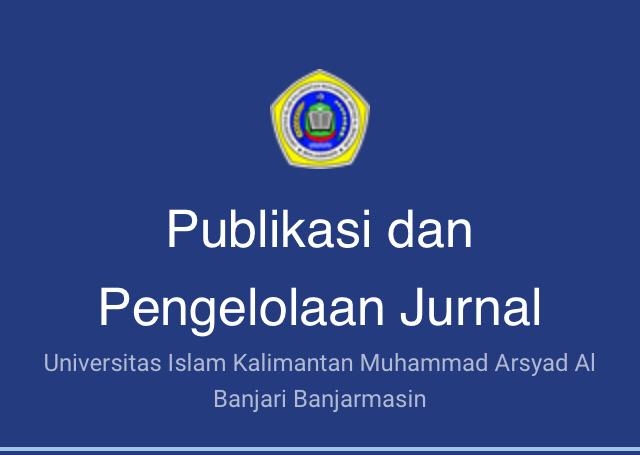DAMPAK FINANCIAL QUOTIENT DAN LIFESTYLE TERHADAP FINANCIAL BEHAVIOR DOSEN WANITA DI STIE PANCASETIA BANJARMASIN
(1) Sekolah Tinggi Ilmu Ekonomi Pancasetia Banjarmasin, Indonesia
(2) Faculty Economy and Business, University of 17 Agustus 1945 Surabaya, Indonesia
(3) Sekolah Tinggi Ilmu Ekonomi Pancasetia Banjarmasin, Indonesia
(*) Corresponding Author
Sari
Financial behavior is a reflection of human behavior in managing their finances, many things that can affect, including financial quotient and lifestyles. The aim of the study is to understand the impact of financial quotient and lifestyles on financial behavior of female lecturers at STIE Pancasetia Banjarmasin. Data was collected through indepth- interview with three resource persons who teach finance or e-commerce. Understanding financial does not necessarily make a person implement it comprehensively in life, especially for female workers who are relatively young, there is a tendency not to pay attention to risks and protection for their future. Today’s lifestyle is closely related to the nurture, and this can be seen from their habits in using money. Individuals with better financial quotient will better understand how to plan the utilization of their income so they will choose a lifestyle that suits them, so they will behave in accordance with these choices.
Kata Kunci
Teks Lengkap:
PDFReferensi
Andarsari, P. R., & Ningtyas., M. N. (2019). The Role of Financial Literacy on
Financial Behavior. Journal on Accounting and Business Education, 4(1). Atkinson, A., & Messy, F.-A. (2012). Measuring Financial Literacy: Results of
The OECD / International Network on Financial Education (INFE) Pilot Study. OECD Working Papers on Finance, Insurance and Private Pensions, 15.
Baker, H. K., Filbeck, G., & Ricciardi, V. (2017). Financial Behavior: An
Overview. In t. F. Series, Financial Behavior – Players, Services, Products, and Markets. Oxford University Press.
Borden, L. M., Lee, S. A., Serido, J., & Collins, D. (2008). Changing college students’ nancial knowledge, attitudes, and behavior through seminar participation. Journal of Economic Familly Issue, 29(1), 23-40.
Chinen, K., & Endo, H. (2012). Effects of Attitude and Background on Personal
Financial Ability: A Student Survey in the United States. International
Journal of Management, 29(2), 778-791.
Dennis, C., Morgan, A., Wright, L., & Jayawardhena, C. (2010). The Influence
of Social e-shopping in Enhancing Young Women's Online Shopping
Behavior. Journal of Customer Behavior, 9(2), 151-174.
Fraj, E., & Martinez, E. (2006). Environmental Values And Lifestyles As Determining Factors Of Ecological Consumer Behaviour: An Empirical Analysis . Journal of consumer marketing, 23(3), 133-144.
Garber, G., & Koyama, S. (2016). Policy-Effective Financial Knowledge and
Attitude Factors. Working Paper Series.
Halimatussakdiyah, Martono, S., & Sudarma, K. (2019). Influence of Life Style
and Financial Literacy to Consumptive Behavior through Self-Control
of Unisnu FEB College Students Jepara. Journal of Economic Education,
(1), 75-80.
Handa, M., & Khare, A. (2013). Gender as a Moderator of the Relationship
between Materialism and Fashion Clothing Invovement among Indian
Youth. International Journal of Consumen Studies, 112-120.
He, Y., Zou, D., & Jin, L. (2010). Exploiting The Goldmine: A Lifestyle Analysis
Of Affluent Chinese Consumers. Journal of consumer marketing, 27(7),
-628.
Herdjiono, I., & Damanik, L. A. (2016, Desember). Pengaruh Financial
Attitude, Financial Knowledge, Parental Income Terhadap Financial
Management Behavior. Jurnal Manajemen Teori dan Terapan, 9(3), 226-
Hilgert, M. A., Hogarth, J. M., & Beverly, S. G. (2003, July). Household Financial Management:The Connection between Knowledge and Behavior. Federal Reserve Bulletin, 309-322.
household. (n.d.) Collins Dictionary of Economics, 4. e. (2020, April 13).
thefreedictionary.com. Retrieved April 14, 2020, from TheFreeDictionary:
https://financial-dictionary.thefreedictionary.com/household
Hung, A. A., Parker, A. M., & Yoong, J. K. (2009, September 23). Defining and
Measuring Financial Literacy. Retrieved from http://www.rand.org.
Husnan, S. (2019). Pengertian dan Konsep-Konsep Dasar Keuangan. In S.
Husnan, Modul Manajemen Keuangan. Jakarta: Universitas Terbuka.
Huston, S. J. (2010). Measuring Financial Literacy. The Journal of Consumer
Affairs, 44(2), 296-316.
IDA. (2020, maret 29). IDA Wealth. Retrieved April 2, 2020, from Intelligence
Driven Advisor: https://www.idawealth.com/iq-eq-and-the-financial- quotient/
Ishawini, & Datta, S. (2011). Pro-Environmental Concerns Influencing Green Buying: a Study on Indian Consumers. International Journal of Business and Management, 6, 124-133.
Kholilah, N. A., & Iramani, R. (2013, May). Studi Financial Management
Behavior pada Masyarakat Surabaya. Journal of Business and Banking,
(1), 69 – 80.
Khraim, H. S. (2015). Segmentation Of Young Consumers In Jordan In Terms Of Their Lifestyle: An Exploratory Study. American Journal of Business and Management, 4(1), 27-37.
Lestari, M. R. (2016, Oktober 05). www.netralnews.com. (L. Eppang, Ed.)
Retrieved April 12, 2020, from NETRALNEWS.COM :
https://www.netralnews.com
Livingston, A. (2018). Men, Women & Money – How the Sexes Differ With Their Finances. Retrieved April 1, 2020, from Money Crashers, LLC: https://www.moneycrashers.com/men-women-money-sexes-differ- finances/
Lontoc, G. K. (2019, May 1). Applying The Financial Quotient Daily. Retrieved April 2, 2020, from BussinessMirror: https://businessmirror.com.ph/2019/05/01/applying-the-financial- quotient-daily/
Lusardi, A., & Mitchell, O. (2014). The Economic Importance of Financial
Literacy: Theory and Evidence. Journal of Economic Literature, 52(1), 5-44. Lynch, J. (2011). Introduction to the Journal of Marketing Research special
interdisciplinary issue on consumer financial decision making. Journal of
Marketing Research, 4-8.
Mohiuddin, Z. A. (2018). Effect of Lifestyle on Consumer Decision Making: A Study of Women Consumer of Pakistan. Journal of Accounting, Business and Finance Research, 2(1), 12-15.
Mujanah, S., Ratnawati, T., & Kusmaningtyas, A. (2019, March). The Effect of
Competence, Emotional Quotient, and Financial Quotient on The
Business Performance of Small and Medium Enterprises in Surabaya, Indonesia. In 16th International Symposium on Management (INSYMA
.
Nano, D. (2015, November). The Interrelationship between Financial Attitude,
Financial Behavior and Financial Knowledge. International Journal of
Business and Technology, 4(1).
Niinimaki, K. (2010). Eco-Clothing, Consumer Identity And Ideology.
Sustainable Development, 18, 150-162.
Nobriyanni, A. P., & Haryono, N. A. (2019). Faktor-faktor yang Memengaruhi Financial Management Behavior pada Keluarga TKI di Kabupaten Ponorogo. Jurnal Ilmu Manajemen , 7(3).
Paramasivan, C., & Subramanian, T. (n.d.). Financial Management. New Delhi:
New Age International Publishers.
Ratnawati, H. T., Rohmasari, F., & Lokajaya, I. N. (2017, September). Financial
Literacy And Financial Inclusion Strategy Model As Leverage Welfare
Of Industrial Community Tourism Regency Of Gresik East Java. Jurnal
Penelitian LPPM Untag Surabaya, 2(1).
Ricciardi, V. (2008). Risk: Traditional Finance versus Behavioral Finance . In F.
J. Fabozzi, The Handbook of Finance Volume 3: Valuation, Financial Modeling, and Quantitative Tools (pp. 11-38). Hoboken, NJ: John Wiley & sons, Inc.
Robb, C. A., & Woodyard, A. S. (2011). Financial Knowledge and Best Practice
Behavior. Journal of Financial Counseling and Planning, 22(1), 60-70.
Rooij, M. V., Lusardi, A., & R.J.M., A. (2012). Financial Literacy, Retirement
Planning and Household Wealth. The Economic Journal, 122(560), 449-
Sharma, S., & Lal, K. (2012). Changing Consumen Behavior - A Challenge for
Sustainable Business Growth. International Journal of Marketing, Financial
Services & Management Research, 1(8), 149-158.
Sholz, J. (2012). Myth Busting: Living in Harmony with Nature is Less
Harmonic than it Seems . Research in Consumer Behavior, 297-313.
Skals, M. V. (2020, January 29). AARHUS BSS School of Business and Social Science. (AARHUS University) Retrieved April 14, 2020, from bss.au.dk: https://econ.au.dk/research/data-and-computational-resources/research- themes/household-finance/
Tian, K. T., Bearden, W. O., & Hunter, G. L. (2001, June). Consumers’ Need for
Uniqueness: Scale Development and Validation. Journal of Consumer
Research, 28(1), 50-66.
Todd, S., & Lawson, R. (2003). Towards an understanding of frugal consumers.
Australian Marketing Journa, 1(3), 8-18.
Vermeir, I., & Verbeke, W. (2008). Sustainable food consumption among young adults in Belgium: Theory of planned behaviour and the role of confidence and values. Ecological (Tian, Bearden, & Hunter,
economics, 64(3), 542-553. Ecological Economics, 64(3), 542-553.
Vitt, L. A., Anderson, C., Kent, J., Lyter, D. M., Siegenthaler, J. K., & Ward, J. (2000, January). Personal Finance and the Rush to Competence: Financial Literacy Education in the U.S.
Workman, J., & Lee, S. (2011). Vanity and Public Self-Consciuousness: A
Comparison of Fashion Consumen Groups and Gender. International
Journal of Consumen Studies, 35(3), 307-315.
Xiao, J. (2009). Applying behavior theories to financial behavior . In Handbook of
Consumer Finance and Research (pp. 69-81).
Young, W., Hwang, K., McDonald, S., & Oates, C. (2010). Sustainable
consumption: Green consumer behaviour when purchasing products.
Sustainable Development , 18(1), 20-31.
DOI: http://dx.doi.org/10.31602/al-kalam.v7i2.3251
Refbacks
- Saat ini tidak ada refbacks.

Al Kalam : Jurnal Komunikasi, Bisnis, dan Manajemen by https://ojs.uniska-bjm.ac.id/index.php/alkalam/index adalah ciptaan disebarluaskan di bawah Lisensi Creative Commons Atribusi-BerbagiSerupa 4.0 Internasional.









